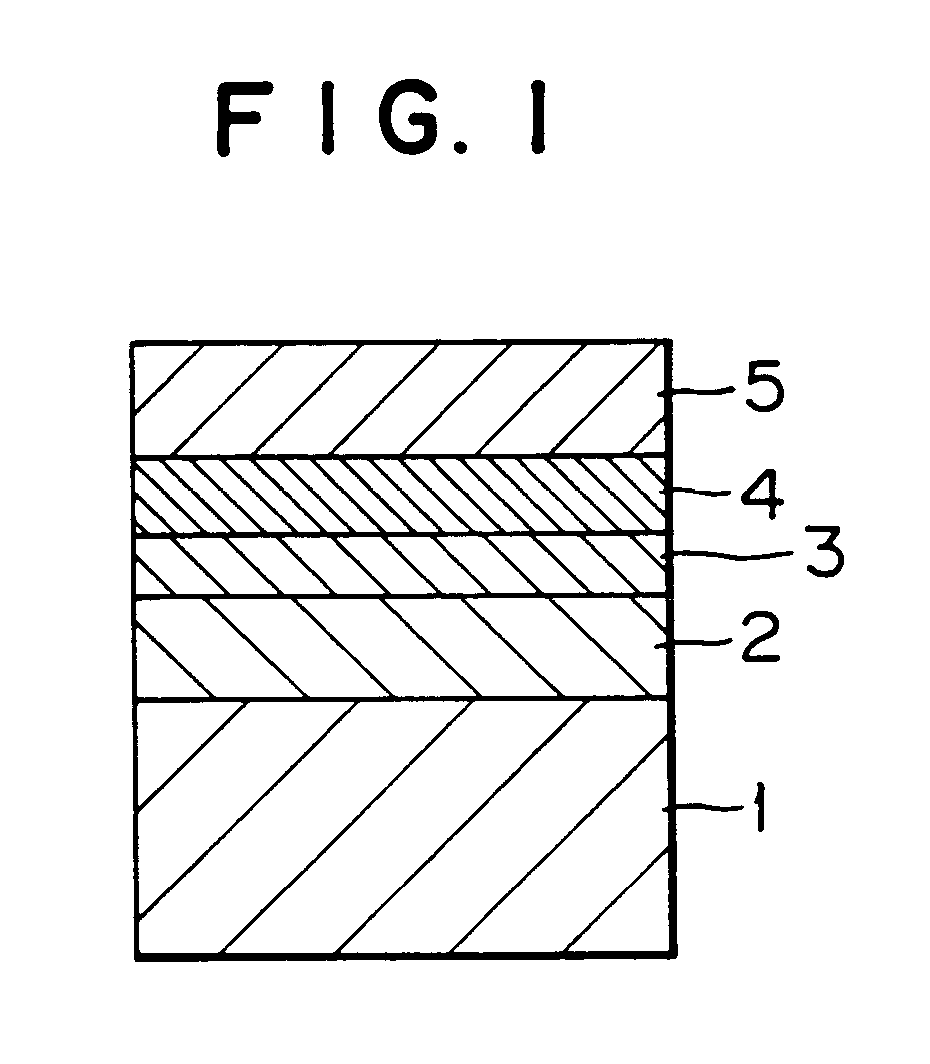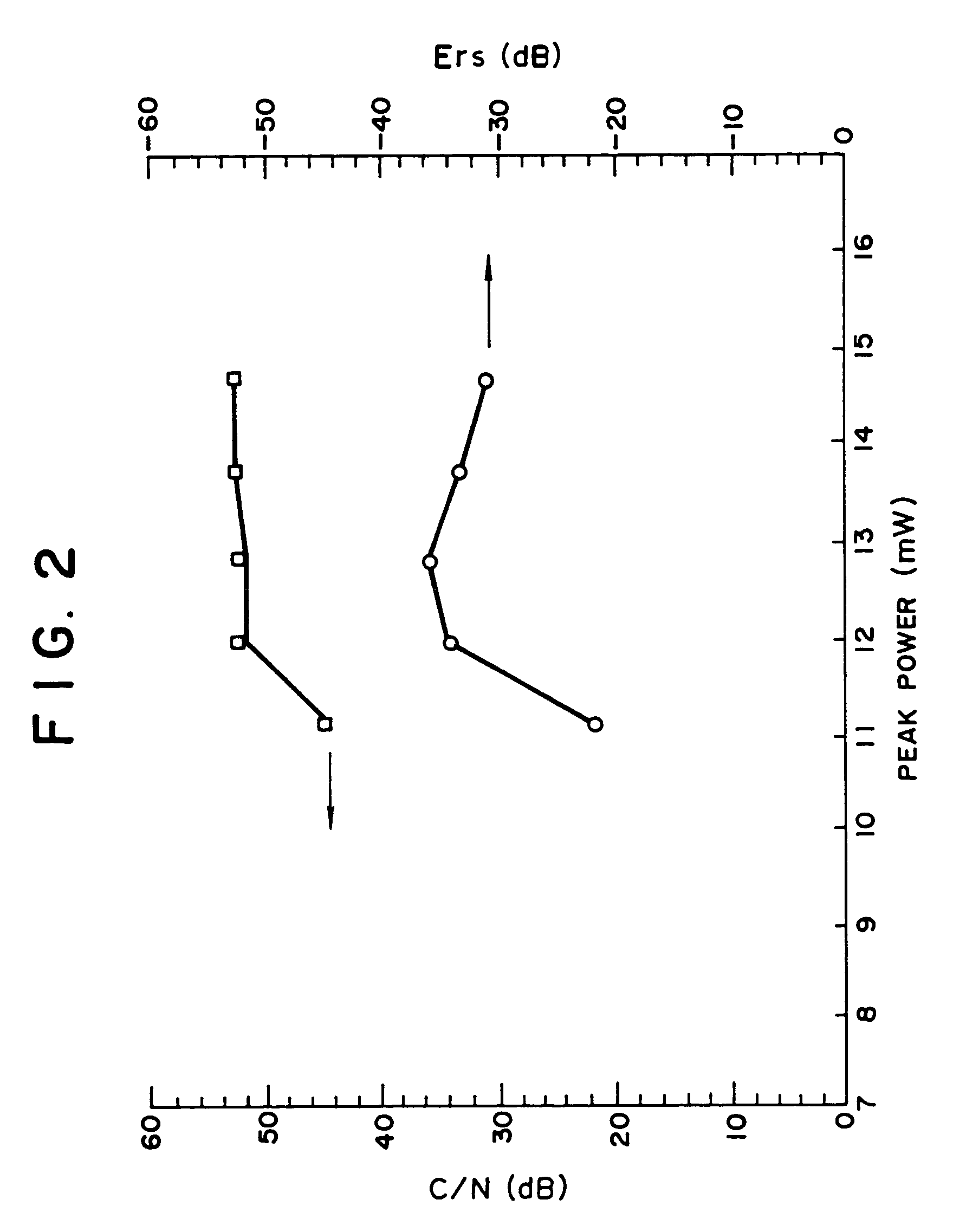Method of producing a sputtering target
a target and target technology, applied in the field of sputtering targets, can solve the problems of insufficient laser power required for recording and erasing, the above-mentioned conventional phase-change optical recording media cannot meet all the requirements of phase-change rewritable optical recording medium requirements, and the difficulty of overwriting, etc., to achieve the effect of improving the c/n ratio, erasability, and repeatability
- Summary
- Abstract
- Description
- Claims
- Application Information
AI Technical Summary
Benefits of technology
Problems solved by technology
Method used
Image
Examples
example 9
[0129]The procedure for fabricating the disk-shaped optical recording medium No. 5 in Example 5 was repeated except that the method of producing the target for fabricating the recording layer of the recording medium No. 5 in Example 5 did not include the heat treatment step prior to the sintering step. Thus, a disk-shaped optical recording medium No. 9 according to the present invention was fabricated.
[0130]The overwriting characteristics of the optical recording medium No. 9 were evaluated at a linear speed of 5 m / sec in the same manner as in Example 5.
[0131]FIG. 3 is a graph which shows the overwriting characteristics of the optical recording medium No. 9.
[0132]In comparison with the graph of FIG. 3, the optical recording medium No. 5 is superior to the recording medium No. 9 with respect to the disk characteristics, such as the C / N ratio and the erasability, and the overwriting sensitivity.
examples 10 to 12
[0133]The procedure for fabricating the disk-shaped optical recording medium No. 3 in Example 3 was repeated except that nitrogen gas was contained in the atmosphere with concentrations of 3.0, 6.0, and 10.0 mol %, respectively in Example 10, Example 11, and Example 12 when the recording layer was formed on the first heat-resistant protective layer by sputtering.
[0134]Thus, disk-shaped optical recording media Nos. 10 to 12 according to the present invention were fabricated.
[0135]Table 2 shows the composition of each of the thus obtained recording layers in terms of the atomic percents of constituent elements.
[0136]In the same manner as in Example 1, each of the optical recording media Nos. 3, 10, 11 and 12 according to the present invention was repeatedly subjected to the overwriting operation, and the maximum number of the repeated overwriting operations was obtained.
[0137]The results are also shown in Table 2.
[0138]
TABLE 2MaximumNumber ofComposition ofOptimalRepeatedN2 / Recording L...
example 13
[0143]It was confirmed that each of the sputtering targets employed in Examples 1 to 8 for fabricating each recording layer comprises AgInTe2 crystallites with a particle size of 450 Å or less.
[0144]The procedure for fabricating the disk-shaped optical recording medium No. 2 in Example 2 was repeated except that the target for fabricating the recording layer of the recording medium No. 2 in Example 2 was replaced by a target with the same composition as that of the target employed in Example 2, with the particle size of the AgInTe2 crystallites for use in the target material being controlled to 500 Å.
[0145]Thus, a disk-shaped optical recording medium No. 13 according to the present invention was fabricated.
[0146]The overwriting characteristics of the optical recording medium No. 13 were compared with those of the optical recording medium No. 2 by carrying out the overwriting operation at a disk rotation speed of 2 m / s.
[0147]FIG. 4 is a graph which shows the overwriting characteristi...
PUM
| Property | Measurement | Unit |
|---|---|---|
| speed | aaaaa | aaaaa |
| temperature | aaaaa | aaaaa |
| width | aaaaa | aaaaa |
Abstract
Description
Claims
Application Information
 Login to View More
Login to View More - Generate Ideas
- Intellectual Property
- Life Sciences
- Materials
- Tech Scout
- Unparalleled Data Quality
- Higher Quality Content
- 60% Fewer Hallucinations
Browse by: Latest US Patents, China's latest patents, Technical Efficacy Thesaurus, Application Domain, Technology Topic, Popular Technical Reports.
© 2025 PatSnap. All rights reserved.Legal|Privacy policy|Modern Slavery Act Transparency Statement|Sitemap|About US| Contact US: help@patsnap.com



